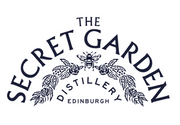Hollyhock and Honey
This gin is made with our staple gin background of Juniper, Winter Savoury, Coriander and Angelica Root - to this we then dissolve some of our own honey (we have 12 hives on site here) to add just a subtle uplift of sweetness and then we add dried black Hollyhock flowers to the gin - this gives a deep black/purple colour which we then add a twist of fresh lemon juice to turn the gin into the most electric pink. The Hollyhock also adds a subtle floral/earthy back note to the gin.
We have grown Hollyhocks (Althea rose) in the garden here from the very beginning for two reasons ; firstly they are truly beautiful, with long spikes with a mass of tissue paper thin brightly coloured flowers - no cottage garden or garden should be without them - they usually grow to 6ft but we have had some growing up to 15ft tall, which makes harvesting the flowers very difficult! Secondly, the flowers are edible and they look great in our salads we serve in the cafe. However, for the gin we specifically grow the Black Hollyhock as the anthocyanins are insane (anthocyanin is a chemical which occurs in some plants, a water-soluble pigments which changes colour when the pH is changed) and the colour change goes from deep black/purple to bright pink.
We also love Hollyhocks in the garden here not just for their beauty, tastiness and the fact that they change colour for our gin but also that our bees love the flowers and there is a natural connectivity between our bees and these flowers but added to this they are also the preferred breeding ground for the wonderfully Painted Lady Butterfly. Originally native to Turkey Hollyhocks came to Britain around 1573 and were very popular in Elizabethan days and were also used medicinally for tuberculosis, badder infections and soothing horses heels!
However, we hope you enjoy this beautiful gin as it celebrates the dance of nature; the bees interacting with the Hollyhock, the caterpillars of the Painted Lady Butterfly making the plant her home too - interweaving their connectivity in the only way nature can. Enjoy x
This gin is made with our staple gin background of Juniper, Winter Savoury, Coriander and Angelica Root - to this we then dissolve some of our own honey (we have 12 hives on site here) to add just a subtle uplift of sweetness and then we add dried black Hollyhock flowers to the gin - this gives a deep black/purple colour which we then add a twist of fresh lemon juice to turn the gin into the most electric pink. The Hollyhock also adds a subtle floral/earthy back note to the gin.
We have grown Hollyhocks (Althea rose) in the garden here from the very beginning for two reasons ; firstly they are truly beautiful, with long spikes with a mass of tissue paper thin brightly coloured flowers - no cottage garden or garden should be without them - they usually grow to 6ft but we have had some growing up to 15ft tall, which makes harvesting the flowers very difficult! Secondly, the flowers are edible and they look great in our salads we serve in the cafe. However, for the gin we specifically grow the Black Hollyhock as the anthocyanins are insane (anthocyanin is a chemical which occurs in some plants, a water-soluble pigments which changes colour when the pH is changed) and the colour change goes from deep black/purple to bright pink.
We also love Hollyhocks in the garden here not just for their beauty, tastiness and the fact that they change colour for our gin but also that our bees love the flowers and there is a natural connectivity between our bees and these flowers but added to this they are also the preferred breeding ground for the wonderfully Painted Lady Butterfly. Originally native to Turkey Hollyhocks came to Britain around 1573 and were very popular in Elizabethan days and were also used medicinally for tuberculosis, badder infections and soothing horses heels!
However, we hope you enjoy this beautiful gin as it celebrates the dance of nature; the bees interacting with the Hollyhock, the caterpillars of the Painted Lady Butterfly making the plant her home too - interweaving their connectivity in the only way nature can. Enjoy x







